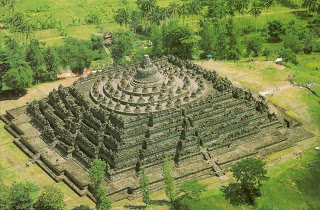Borobudur temple is located in the historical village of Borobudur, Magelang, Central Java. This temple is the second largest Buddhist temple after Ankor Wat temple in Cambodia and belong to one of the seven wonders of the world. There are several versions of the origin of the name of this temple. The first version says that the name comes from the Sanskrit Borobudur is "bara" which means "temple or monastery" and "beduhur" which means "high / above".
The second version says that the name Borobudur History is likely to come from the word "sambharabudhara" which means "mountain slope terraces". The third version is interpreted by prof. Dr. Poerbotjoroko. He explains that the word Borobudur comes from the word "bhoro" which means "monastery" or "dorm" and "budur" which means "above".
Historian J.G. de Casparis in his dissertation for a doctorate in 1950 found that Borobudur is a place of worship. Based on the inscriptions Karangtengah and Kahulunan, Casparis estimate Borobudur is the founder of the dynasty king of Mataram and dynasty named Samaratungga, doing construction around 824 AD.
The giant building could be completed at the time of her daughter, Queen Pramudawardhani. Borobudur Development is expected to take half a century. In Karangtengah inscriptions also mentioned about the bestowal of land sima (tax-free land) by queen of Kahulunan (Pramudawardhani) to maintain Kam? L? N is called Bh? Misambh? Ra. The term Kam? L? N is derived from the word meaning first place origins, ancestral shrine to glorify, probably ancestors of the dynasty Sailendra. Casparis estimates that Bh? mi Sambh? Ra Bhudh? Ra in Sanskrit means "Hill set ten levels boddhisattwa virtues", was the original name of Borobudur.
The location of this temple which is located in the hills above the village of Borobudur, Mungkid, Magelang or 42 km northwest of Yogyakarta. Surrounded Hill Manoreh stretching from east to west. While the east are Mount Merapi and Merbau, and the west side there Gunumg Sindoro and Sumbing.
It takes no less than 2 million blocks of andesite or equivalent square 50.000 meters to build this temple of Borobudur. The overall weight of the temple up to 3.5 million tons. Like most temples, Borobudur have 3 parts of the building wich is legs, body and upper body. Foot building called Kamadhatu, which tells of consciousness filled with lust and animalistic traits. Then Ruphadatu, which means a level of consciousness that is still bound lust, material and shape. While no longer bound Aruphadatu lust, materials and shapes depicted in the form of an empty stupa. This can only be achieved with the desire and emptiness.
Related Article










.jpg)
